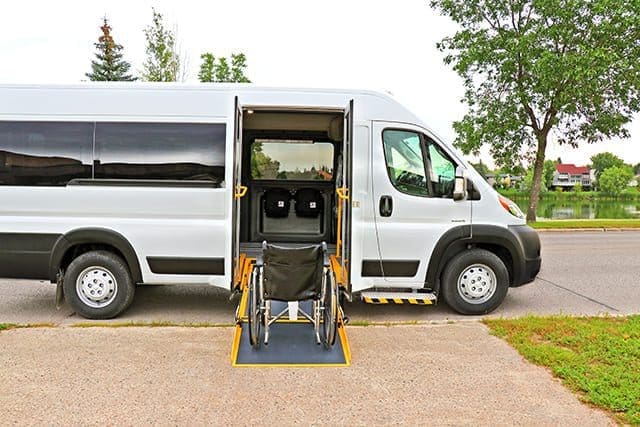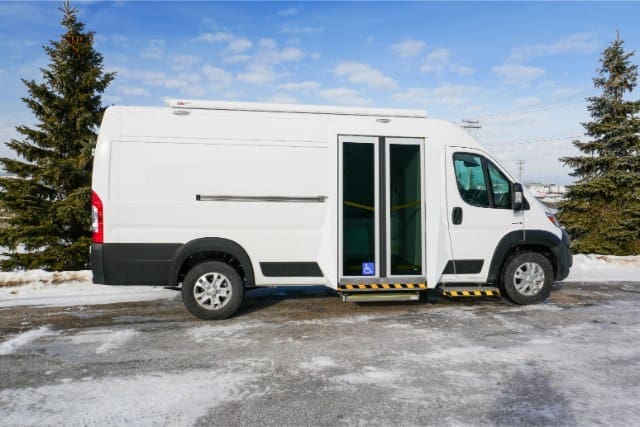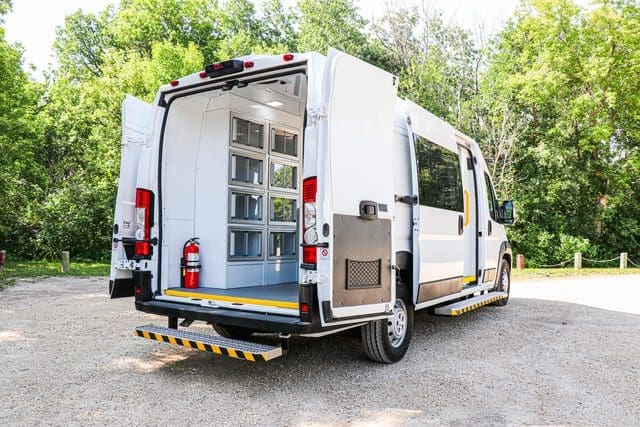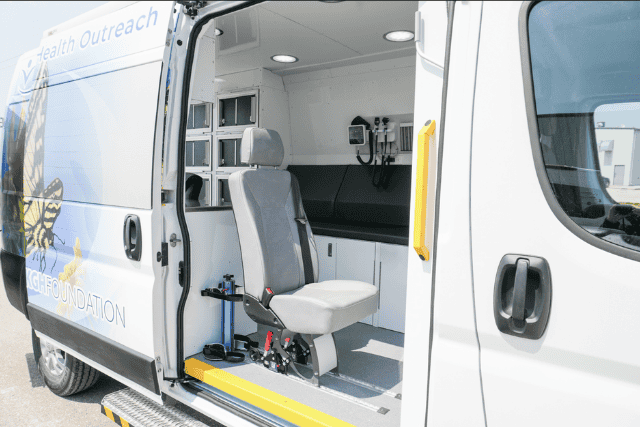Choosing the right wheelchair accessible van can feel overwhelming. You might be thinking, “Where do I even start?” As an organization, you need a vehicle that meets all your needs, from safety and reliability to comfort and convenience.
It’s a significant investment, and you want to ensure you’re making the best choice for your clients. We understand that finding the perfect wheelchair accessible van is about more than just ticking boxes; it’s about making a difference in people’s lives.
At AVAN Mobility, we’ve been leading the way in accessible transportation for over a decade. Our mission is to reduce barriers to healthcare and transportation, ultimately saving lives. We’re innovators dedicated to providing the best solutions for our clients.
While we believe in our products, we also recognize there are other manufacturers out there, and we aim to provide unbiased, helpful information to guide your decision-making process.
In this article, you’ll learn how to choose the right wheelchair accessible van in 11 steps. We’ll cover everything from assessing your needs to understanding key features. Our goal is to make this journey as smooth and informed as possible for you.
How to choose a wheelchair accessible van in 11 steps
Here are the 11 steps to choosing a wheelchair accessible van at a glance:
- Choose between a new or pre-owned van
- Select a side entry or rear entry model
- Assess the size and weight of the wheelchairs
- Determine the number of wheelchairs you’ll be transporting
- Decide if walkers need to be accommodated
- Identify if the wheelchair is manual or electric
- Do you want a ramp or a lift?
- Measure the seated height of the wheelchair user(s)
- Consider the frequency of long-distance trips
- Evaluate the amount of equipment you need to carry
- Set a budget
Let’s dive in and take a closer look at each step so you can make the best choice for your organization.
1. Choose between a new or pre-owned van
When deciding between a new or pre-owned wheelchair-accessible van, there are factors to consider.
New Vans:
- Reliability: New vans are more dependable and experience fewer service issues.
- Warranty protection: Manufacturer warranties provide peace of mind.
- Customization: You can request specific features and configurations tailored to your needs.
Pre-Owned Vans:
- Cost savings: Generally more affordable for budget-conscious buyers.
- Potential service issues: Used vans may come with more service problems.
- Limited customization: Pre-owned vans have existing conversions, so options are limited. What you see is what you get, which might not fully meet your requirements.
2. Select a side entry or rear entry model
Choosing between a side entry and rear entry model depends on your specific needs and parking situations. Here’s a quick comparison to help you decide:
| Side Entry | Rear Entry |
| Good for passengers with any mobility level (wheelchair, walker, ambulatory) | Easy to roll wheelchairs straight in and out |
| Needs space on the side to lower the ramp | Can be unsafe if unloading on a busy street |
| Great for loading from curbs | No special parking spot needed |
3. Assess the size and weight of the wheelchairs
Knowing the size and weight of the wheelchairs you’ll be transporting is another important step to think about when deciding on a wheelchair accessible van.
Ramp difficulty: Some ramps are easier to use than others. Bigger ramps can be more user-friendly, especially for heavier wheelchairs.
Wheelchair dimensions: Measure the width and length of the wheelchairs to make sure they fit comfortably in the van.
Weight matters: Heavier wheelchairs typically need a stronger ramp or a motorized lift for easier access.
Understanding the size and weight of the wheelchairs helps you decide if a ramp or lift is the best choice for your program.
4. Determine the number of wheelchairs you’ll be transporting
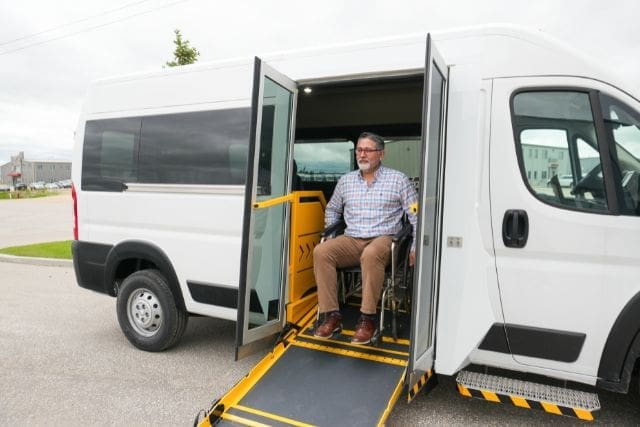
It’s important to know how many wheelchairs you’ll be transporting to choose the right vehicle.
1-2 wheelchairs: An accessible minivan is a great choice. It has enough space and is easy to drive.
2-4 wheelchairs: A full-size wheelchair accessible van is best for 2-4 wheelchairs. It has more room than minivans and can comfortably fit multiple wheelchairs.
More than 4 wheelchairs: If you are transporting more than 4 wheelchairs, you may want to think about getting a different type of wheelchair vehicle, such as a bus.
Picking the right size of vehicle makes sure everyone has enough room and travels comfortably.
5. Decide if walkers need to be accommodated
Will your organization be transporting people who use walkers? If so, consider the following:
Low ramp incline: A wheelchair van with a low ramp incline is best for transporting people with walkers. It ensures the ramp isn’t too steep, providing easier access.
AVAN Mobility vans: Our vans come with a power ramp that has a low incline so people can walk up the smooth and gentle slope.
Avoid intimidating lifts: Sometimes, lifts can intimidate people using walkers. A ramp is often more welcoming and easier to use in these cases.
6. Identify if the wheelchair is manual or electric
Does your organization need to transport manual or electric wheelchairs? The type of wheelchair makes a big difference when considering the ramp angle.
Powered wheelchairs: These can handle steeper ramps without much trouble.
Manual wheelchairs: These have a harder time with steep ramps and need a gentler slope.
Passengers should be able to enter and exit the van easily, so knowing the type of wheelchairs you’ll be transporting helps you choose the right ramp angle for the smoothest experience.
7. Do you want a ramp or a lift?

Choosing between a ramp and a lift can be one of the toughest decisions when selecting a wheelchair accessible van.
Ramps:
- Independence: Ramps give passengers a bit more independence and make it easier for wheelchair users to navigate on their own.
- Driver effort: The driver must be able to push the wheelchair up the ramp, which can be physically demanding.
Lifts
- Ease for drivers: With lifts, drivers don’t have to do anything physically to get the wheelchair user into the vehicle.
- Steps for others: Ambulatory passengers still have to go up steps to get in the van, as the lift blocks the rear or side doorway.
Consider the needs and abilities of both your drivers and passengers when making this choice. At this point in time, we only offer ramps in our wheelchair accessible vans.
8. Measure the seated height of the wheelchair user(s)
Measuring the seated height of wheelchair users is essential because the amount of headroom varies between wheelchair vans. Even a single inch can make a big difference. Knowing the seated height of wheelchair users helps you decide if one vehicle or entry method is more suitable for your organization.
For example, minivans typically have less headroom than full-size wheelchair vans, which might not be ideal for taller wheelchair users.
9. Consider the frequency of long-distance trips
Think about how often you’ll be taking long-distance trips. Comfort is key for wheelchair users, especially when traveling for long periods. Some vans simply ride nicer than others and offer more amenities.
It’s important to choose a van that provides a smooth ride and features that ensure everyone remains comfortable throughout the journey. A comfortable ride can make all the difference on those longer trips.
10. Evaluate the amount of equipment you need to carry
Do your clients bring a lot of gear? The cargo space in your wheelchair accessible van can vary depending on the type of conversion you get. Some entry methods, like ramps and lifts, can take up more space than others.
If your clients are hauling around a lot of stuff, you’ll definitely want to consider the cargo space in your wheelchair van. Think of it like playing a game of Tetris—you need to make sure everything fits just right. Otherwise, you might end up with a van packed tighter than a suitcase after holiday shopping!
11.Set a budget
Have you set a budget for your wheelchair accessible van? Your budget will depend on the type of vehicle and the specific features you choose. At AVAN Mobility, you can expect to pay between $120,000 and $170,000 for a wheelchair accessible van. Prices vary depending on conversion and are subject to change at any time.
Knowing your budget ahead of time helps narrow down your options and ensures you find the best van that fits your financial plan.
Ready to find your next wheelchair accessible van?

You came to this article looking for guidance on choosing the right wheelchair accessible van, and hopefully, you feel more confident in making that decision now. We’ve walked you through 11 essential steps, from deciding between new and pre-owned vans to setting your budget.
At AVAN Mobility, we pride ourselves on reducing barriers to healthcare and transportation with our innovative vehicles. With over a decade of experience, we’re here to ensure you find the perfect van to meet your needs. We believe in making a difference, one van at a time. If you have any questions or need further assistance, click the button below to talk to a mobility expert. Our team is always ready to help.
If you’re not ready to talk to a mobility expert yet, we have a few other resources you should check out to learn more.
To start with, check out our video on the cost of a wheelchair accessible van. This will give you a better idea when you reach step 11 as discussed above, and start budgeting.
In addition, check out our P4 and P5 wheelchair accessible vans to see if they make sense for your organization.
